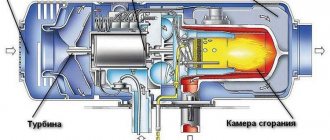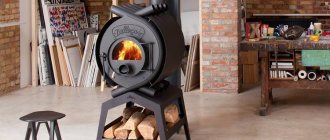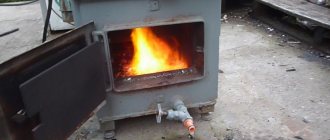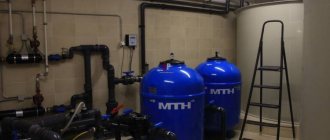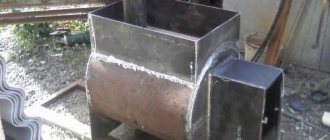Advantages and disadvantages
Any option for creating or purchasing a stove to maintain the desired temperature in the garage has both positive and negative sides. There is no need to stop at the first option that comes to you.
Only by examining and analyzing them, as well as taking into account all the positive and negative aspects, can you finally decide on the choice in each specific situation.
The positive points are:
- Low cost of the fuel used and its low consumption compared to wood or coal.
- Low amount of harmful emissions into the room and atmospheric air. But it is worth remembering about safety; any process of burning hydrocarbons is accompanied by the release of a life-threatening, insidious and invisible gas - carbon monoxide, which has no odor. Therefore, issues of room ventilation should be treated with great responsibility.
- Availability and low cost of materials for the construction of such a furnace; all you need is a little metal.
- The ease of manufacturing such a stove; even a person who is far from the intricacies of metalworking can cope with such work. All you need is to be able to use a grinder and a welding machine.
- Possibility of reliable operation in cold and warm seasons.
- Small dimensions of the heating unit.
There are fewer negative aspects, but they also exist:
- The stove emits the smell of burnt petroleum products, and the effect of carbon monoxide on the human body was described above.
- The heating device needs to be cleaned regularly, at least once a week.
- If a diesel stove is not properly maintained, it often fails.
- Electrical heating appliances and other hot surfaces should not be used near such a stove.
Tips for choosing a device
To choose the right heat source, you need to consider where and how it will be used. We have formulated 5 tips for choosing it successfully:
For occasional short-term use in the garage, on construction sites and field work, liquid fuel models are ideal; If you have access to firewood or coal, we advise you to pay attention to potbelly stoves and the Buleryan stove. Many models are simply created for installation in a country house and emphasize the surroundings of bathhouses and log houses; Convectors are well suited for permanent operation and installation on walls; Infrared heaters allow you to quickly and with minimal energy consumption warm a local area of the room, for example, a bed or work area
They are also suitable for relaxing in the garden in cool autumn weather; Oil radiators are ideal for “reheating” a room when central heating cannot cope.
Watch a video about choosing a powerful but safe heater
Varieties
Based on the manufacturing method, a distinction is made between factory-made and home-made stoves. Ready-made stoves will cost more, but the buyer of such a unit will save time and money on independently manufacturing such a device. A diesel fuel stove for a garage is one thing that you shouldn’t skimp on, because... it pays for itself very quickly, you just need to take proper care of it.
According to the heating method, all diesel stoves can be divided into models with direct heating, as well as stoves with indirect heating. Direct heating devices do not have a system for removing exhaust gases, so they are not suitable for small rooms; the concentration of CO in the garage will be increased, which can lead to carbon monoxide poisoning. Indirect heating devices are in great demand because of their safety; they are somewhat more complex and consist of:
- Fuel tank (powered by diesel fuel).
- Combustion chambers.
- Nozzles and adjustment screws.
- Main building.
The principle of their operation is similar to a diesel engine of a tractor or bulldozer; fuel flows from the tank through a nozzle into the chamber where diesel combustion occurs. Next, through the heat exchanger and nozzle, the heated air exits into the heated space.
Based on the type of fuel used, there are stoves that run only on diesel fuel, fuel oil or waste engine oil. There are also universal stoves (most often homemade) that can operate on any of the listed types of fuel.
Security measures
Please note that when installing a diesel stove, you should take into account safety regulations and recommendations of specialists:
- the length of the chimney must be at least 4 m;
- Instead of diesel fuel, used oil can be used;
- the oven requires periodic cleaning - every two weeks with regular use;
- for kindling you need a rag or a piece of newspaper soaked in diesel fuel - it needs to be set on fire and placed in the combustion chamber, the rest of the fuel will ignite when the required temperature is reached;
- the heated room must be protected from drafts, but at the same time ensure high-quality ventilation;
- toxic combustion products are formed only during the ignition process - a special outlet can be built for them;
- The stove must be installed at a distance from flammable objects to avoid fire;
- There should be at least 50 cm of free space around the stove on all sides.
Which diesel stove to choose?
When choosing a stove for a garage that is powered by diesel fuel, you should take into account a number of characteristics, such as the power of the stove, the material of manufacture, the possibility of use at different times of the year, the price factor, etc.
Criteria
Power
An important parameter, because the more powerful the stove, the larger the area of the room it can quickly and efficiently heat. On average, for heating 10 square meters. meters of room you need to spend 1 kW of energy.
Based on these data, and knowing the area of your garage, you can calculate what power stove you need to purchase or manufacture.
Material of manufacture
Such devices are made mainly of steel - metal sheets and corners using welded joints. There are also homemade drip-type stoves, which are made from pipes or old gas cylinders.
The lower hemisphere of such a cylinder is used as a bowl where combustion occurs, and the fuel tank is placed outside the body; diesel fuel is dosed to the source of the flame through a metal tube, which eliminates spontaneous combustion.
Price factor
Prices for diesel stoves for garages are quite low, as well as for diesel fuel or fuel oil, and every car enthusiast has used oil on hand. From an economic point of view, such a heating device would be the best option.
Prices for stoves using diesel fuel start from 3,000 rubles. Diesel furnaces that run on fuel oil or waste oil are slightly more expensive.
Other points
- An important point is that the stove has an inspection window (plug). This allows you to control the combustion process and increase or decrease the supply of air mixture to the compartment where fuel combustion occurs.
- According to their dimensions and installation method, diesel stoves can be either large stationary or small portable. The choice here is huge and everyone can choose a unit based on their specific needs, goals and objectives.
Popular models
- Multeat Eco 18. The model runs on used engine oil. Its cost is 21,500 rubles. The stove does not include a fuel tank; any tank with a tap and a fuel filter can be used as one. There is a system for controlling the supply of fuel to the combustion plate.
- Solar gas PO-2.5 Compact and inexpensive stove running on diesel fuel. It will cost the buyer only 3,300 rubles and is capable of heating a room of up to 25 square meters. meters, its power is 2.5 kW. It is very popular among hikers, summer residents and owners of small garages.
- Ritsa. A budget option for an oil-fired furnace. With the ability to heat an area of up to 150 sq. meters, its price will be only 7,000 rubles. There is a chimney and a 10 liter fuel tank.
- Polarus. A powerful heating unit for large rooms, the fuel used is waste machine oil. This 60 kW furnace is capable of heating 3000 cubic meters of air per hour. Price – 65,000 rubles.
- Multeat MUL. Another solid device for large areas in the form of a convection oven, running on old machine oil. Its cost is 56,500 rubles. Multeat MUL is capable of working both on waste fuel and on a mixture of diesel fuel and oil. Recommended for rooms up to 800 cubic meters.
Top 2. FDIK 01
Rating (2021): 4.85
271 reviews taken into account from resources: AliExpress
Best quality The heater is made of durable aluminum, the workmanship is close to ideal. The device body is not damaged during shipment thanks to several layers of packaging.
- Characteristics
Average price: 10,773 rub.
- Material: aluminum, stainless steel
- Dimensions and weight: 17*13.2*38 cm, 8.2 kg
- Fuel consumption: 0.1–0.46 l/h (air 60–185 m³/h)
- Claimed power: 1500–5000 W
- Operating temperature: -40°C to +40°C
FDIK 01 differs from other heaters in its high-quality aluminum housing with overheating protection. Another feature of the model is the intelligent control board. It provides automatic adjustment of temperature and fuel consumption. Due to this, it is possible to save significantly. The autonomous heater received good reviews on AliExpress. They praise the quality of workmanship and durable body without foreign odors. Not all buyers like the fact that the temperature cannot be controlled manually. To reduce or increase heating, you need to change the power of the device. Another drawback is that sometimes the seller forgets to put a muffler in the package; it is sent separately.
Advantages and disadvantages
- Minimum weight
- Quality materials and workmanship
- Intelligent regulation of temperature and fuel consumption
- Lifetime Warranty
- No manual temperature control
- Complex installation
- Sometimes the kit comes without a muffler
Buy on AliExpress.com
See also:
- 10 Best Garage Heaters
Save up to 10% or more when shopping on AliExpress! Use current promotional codes and coupons.
Making a diesel stove with your own hands
Most of the diesel stoves in garages of car enthusiasts are not purchased, but homemade. Below is an example of a drawing of two drip-type stoves operating on diesel fuel; the first version is made from a gas cylinder and is intended for heating liquid in a closed circuit, and the second, made from a piece of pipe, is for air heating of the room.
Drawings of a diesel stove for a garage
Description of structural elements
What will be needed for production?
The main materials will be steel sheets, angles, pipes for the air duct, fasteners (bolts), a cylinder or a piece of pipe - it all depends on the imagination and capabilities of the designer. The tools you will need are:
- Welding machine.
- Bulgarian.
- Spanners.
- Measuring and marking tool.
Main stages of manufacturing
- The first step is to make four legs from the corners, their length is 25 - 30 cm.
- By welding, attach them to the lower compartment of the future structure.
- Make two holes for pipes in the lower and upper parts of the stove; the diameter of the lower one should be smaller than that of the upper outlet.
- Weld the lower pipeline, as well as a small piece of the upper pipe under the air duct. It should be removable and make it possible to conveniently clean the furnace boiler.
- Install the lower and upper parts of the stove, as well as the pipe for the burner. The flame will burn in the lower compartment, fuel will be supplied through the tube, and the upper part will act as a radiator.
- 10 - 12 holes need to be made in the fuel pipe at a distance of 5 cm between them, the first and last holes should be located no closer than 10 cm from the body of the diesel stove.
- Make a round window with a diameter of 15 cm in the fuel compartment and attach a plug to it using bolts. With its help, during the combustion of hydrocarbons, you can regulate the oxygen supply and draft.
- Install the chimney on the top of the stove and take it outside the room.
Design example
Another implementation option
In the video you can see various implementations of diesel fuel stoves:
Catalytic gas heaters
Such devices are considered the safest and most environmentally friendly among gas heaters, since they do not use open flames. As a result, gas combustion products harmful to health and the environment are not produced. The heating element in the device is made of fiberglass, onto which a catalyst is applied. When the gas interacts with the heating element, a chemical reaction occurs that, when completed, releases heat into the air.
TOP 3 best gas heaters Timberk
- Timberk TGH 4200 M1
- Timberk TGH 4200 O3
- Timberk TGH 4200 X2
Heating cables
Laying a heated floor in a garage is not always advisable, but in one situation such a design will be more than justified. We are talking about starting a car in cold weather - often a lot of problems are associated with this, and the presence of a heating cable will significantly simplify the task. In addition, you can lay the cable only under the car and turn it on only if you have problems starting the engine.
The machine must first be covered with a cover that will cover it completely - this will allow the thermal energy to be concentrated in one zone.
The air will not move into the garage itself, so the level of heat loss will be minimized. This technique will allow you to quickly warm up the car even in severe frost. Date: September 25, 2022
